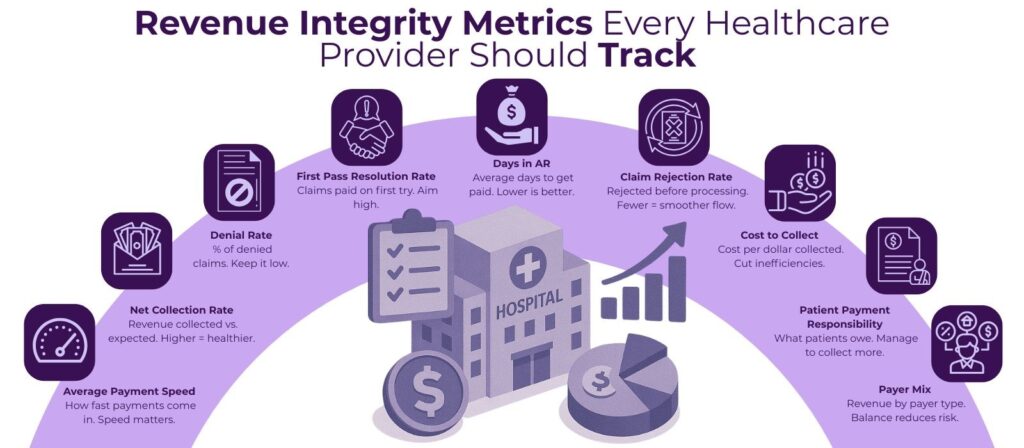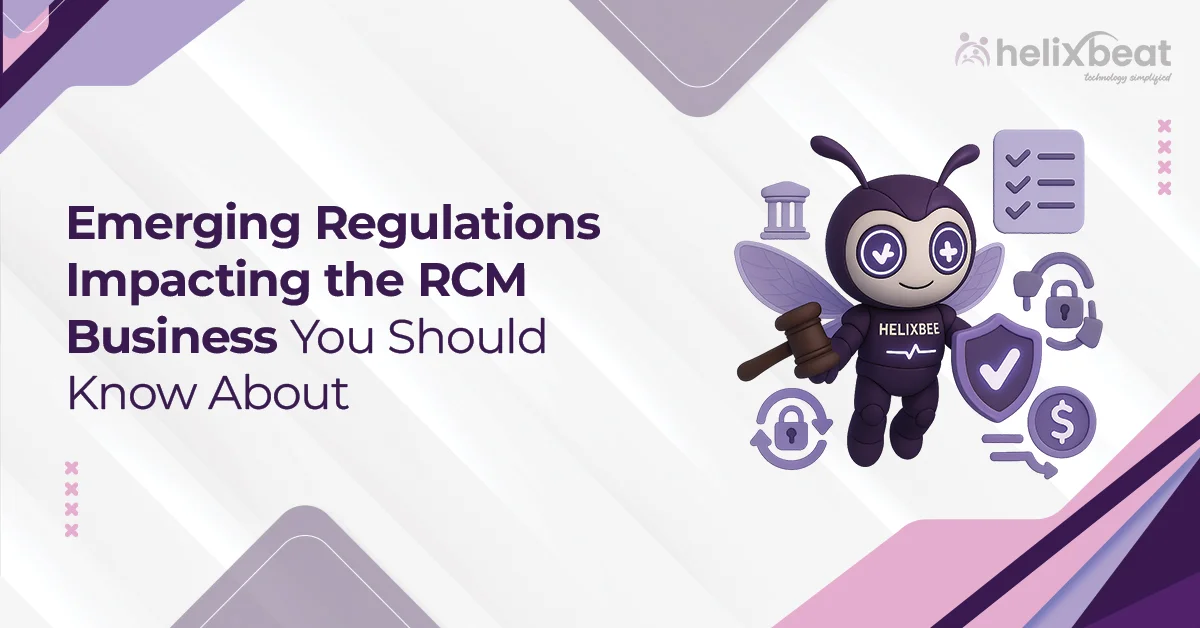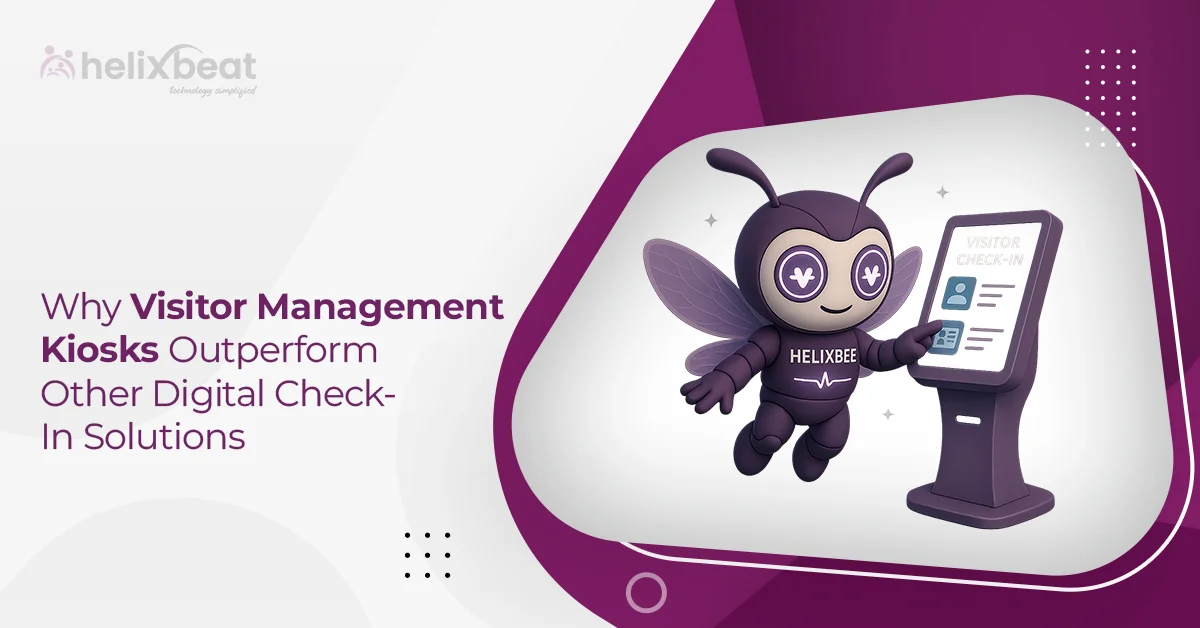Financial stability for your hospital is no longer something you can compromise on. Recent studies indicate that healthcare providers lose approximately $125 billion annually due to revenue inefficiencies, including billing errors, claim denials, and delayed payments. These losses don’t just hurt your bottom line—they also affect the care you can provide to patients. That’s why tracking important revenue metrics like days in accounts receivable, denial rates, and patient payment responsibilities is so crucial.
Keeping a close eye on these numbers helps you catch problems early, speed up payments, and reduce costly errors. At Helixbeat, we understand these challenges and offer revenue cycle management solutions designed to protect your revenue, simplify billing, and maintain your hospital’s financial health, so you can focus on delivering exceptional care.
In this blog, we’ll explore revenue integrity metrics that healthcare providers should monitor.
Table of Contents
What is Revenue Cycle Management (RCM)?
Revenue Cycle Management, or RCM, is the heartbeat of your hospital’s financial system. It’s all about tracking every dollar that comes in from the moment a patient schedules an appointment to the time their bill is fully paid. This includes handling insurance claims, patient billing, coding, collections, and everything in between.
When done right, RCM makes sure your hospital gets paid correctly and on time—for every service you provide. It also reduces the chances of missed payments, billing errors, and claim denials, which are some of the biggest reasons healthcare providers lose money.
In simple terms: RCM helps your hospital stay financially strong so you can keep focusing on what really matters—taking care of your patients

Key Revenue Cycle Metrics You Should Be Tracking
1. Days in Accounts Receivable (AR)
This metric tells you the average number of days it takes to receive payment after a service has been billed. If AR days are high, it may be a sign of delayed claim submissions, payer slowdowns, or internal process inefficiencies. Reducing AR days improves cash flow and helps maintain financial health.
With the RCM of Helixbeat, you benefit from faster billing cycles, automated claim submissions, and timely follow-ups, ensuring minimal delays and maximum healthcare Revenue Integrity.
2. First Pass Resolution Rate
This metric measures how many claims are paid by insurance companies on the very first submission. A high rate means your billing is accurate and clean, while a low rate can indicate coding errors or incomplete patient information.
Thanks to smart automation and accurate documentation, the RCM of Helixbeat enhances the First Pass Resolution Rate, helping healthcare providers boost operational efficiency and ensure healthcare revenue integrity.
3. Denial Rate
This metric tracks how many claims are denied by payers compared to the total number of claims submitted. Frequent denials can signal systemic issues with documentation, coding, or authorization processes and lead to revenue loss if not addressed promptly.
The RCM of Helixbeat offers end-to-end denial management with real-time root cause analysis, making it easier to fix issues at the source and protect healthcare Revenue Integrity.
4. Net Collection Rate
This metric represents the percentage of total reimbursement collected after factoring in insurance payments, patient payments, and contractual adjustments. It reflects how much revenue you’re actually collecting compared to what you should collect.
The RCM of Helixbeat maximizes collections by enhancing payment capture at every stage of the billing cycle, safeguarding healthcare revenue integrity and profitability.
5. Average Payment Speed
This measures how quickly patients and payers are making payments. A longer payment window can hurt cash flow and disrupt operations. Monitoring this helps you understand whether delays are due to claim processing issues or patients needing better billing communication.
Helixbeat’s RCM leverages real-time monitoring tools and automation to speed up the collection process, maintain cash flow, and strengthen Revenue Integrity solutions.
6. Claim Rejection Rate
This metric highlights how often claims are rejected before processing, usually due to errors or incomplete information. Rejected claims must be corrected and resubmitted, which slows down revenue collection and increases labor costs.
With pre-submission validation and scrubbing tools, the RCM of Helixbeat minimizes rejections and enhances clean claim rates, which are essential to achieving strong Revenue Integrity.
7. Cost to Collect
This metric helps you understand how much it costs to bring in every dollar of revenue, including staffing, technology, billing, and collections. If the cost is too high, it signals inefficiencies in your revenue cycle process.
Helixbeat’s RCM solutions reduce operational overhead by automating routine tasks and optimizing workflows, delivering cost-effective revenue integrity solutions that improve your bottom line.
8. Patient Payment Responsibility
As insurance models shift, patients are shouldering more of their healthcare costs. This metric tells you how much revenue you’re expecting from patients after insurance has paid its portion. High patient balances can create collection challenges.
Helixbeat helps improve collections through automated reminders, clear billing statements, and online payment options. Our strategies keep patient balances under control while maintaining Revenue Integrity.
9. Payer Mix
Your payer mix breaks down your revenue sources by payer type—such as Medicare, Medicaid, commercial insurance, or self-pay. A diverse and balanced mix reduces risk and improves cash flow predictability.
The RCM of Helixbeat continuously analyzes payer performance and reimbursement rates, helping you make data-informed decisions to maintain a healthy and stable healthcare revenue integrity environment.
10. Bad Debt Percentage
This tracks the portion of patient accounts that are deemed uncollectible and written off as bad debt. High levels of bad debt can significantly erode profitability and indicate problems with collections or financial counseling.
Through improved patient education, transparent financial policies, and proactive collections, the RCM of Helixbeat reduces bad debt and reinforces sustainable Revenue Integrity practices.
Why Tracking These Metrics Matters
Optimize Billing and Collections
Tracking revenue integrity metrics provides healthcare providers with a clear view of their billing and collection performance. By closely monitoring these metrics, providers can pinpoint inefficiencies such as delays in claims submission, incorrect coding, or gaps in patient eligibility verification. Early identification of these issues enables swift corrections, leading to faster claim approvals and reduced denials. This optimization minimizes revenue leakage and ensures that the billing process is as smooth and accurate as possible, ultimately accelerating cash inflow and strengthening financial health.
Improve Financial Performance
Consistent tracking of revenue integrity metrics helps maintain a healthy cash flow by reducing delays in reimbursements and minimizing bad debts. Metrics such as days in accounts receivable (AR) and net collection rates directly impact the financial stability of healthcare organizations. By understanding and improving these metrics, providers can reduce outstanding receivables and avoid unnecessary write-offs. This leads to enhanced profitability, allowing healthcare organizations to invest more in patient care and technological upgrades without compromising financial viability.
Increase Operational Efficiency
Healthcare revenue cycle operations involve multiple teams and complex workflows. Monitoring key metrics like denial rates and cost to collect reveals bottlenecks and process inefficiencies that cause administrative burdens. By analyzing these data points, providers can streamline workflows, automate repetitive tasks, and optimize staff allocation. This not only improves the speed and accuracy of the revenue cycle but also reduces operational costs, enabling healthcare organizations to operate leaner while maintaining high performance.
Enhance Patient Satisfaction
Patient experience is increasingly influenced by transparent and accurate billing practices. Monitoring revenue integrity metrics ensures that patient registration and insurance verification are error-free, reducing billing disputes and surprise costs. Clear communication regarding patient payment responsibilities—copays, deductibles, and outstanding balances—fosters trust and improves collection rates. When patients understand their financial obligations and receive accurate bills, their satisfaction increases, positively impacting loyalty and retention.
Helixbeat’s Commitment to Revenue Integrity
At Helixbeat, we prioritize Revenue Integrity solutions within our comprehensive Revenue Cycle Management (RCM) services to help healthcare providers navigate the complexities of the modern healthcare financial landscape. Our expert team is dedicated to delivering solutions that improve billing accuracy, maximize reimbursements, and maintain strict regulatory compliance.
Leverage Advanced Analytics and Reporting Tools
Helixbeat empowers healthcare organizations with cutting-edge analytics platforms that provide real-time insights into every stage of the revenue cycle. Our customizable dashboards track critical metrics, enabling proactive management of claims, denials, and payments. These data-driven insights allow providers to identify trends, forecast revenues, and make strategic adjustments that enhance revenue integrity and financial outcomes.
Benefit from Expert Coding and Billing Services
Accurate coding and billing form the foundation of revenue integrity. Our experienced coding specialists ensure compliance with ICD-10, CPT, and HCPCS standards, minimizing errors that can trigger denials or delays. By expertly managing claims submissions and following up with payers, Helixbeat helps reduce rejections and boosts first-pass resolution rates, ensuring providers receive the revenue they rightfully deserve.
Access Real-Time Dashboards for Performance Monitoring
Transparency is key to effective revenue cycle management. Helixbeat provides clients with real-time dashboards that monitor claim statuses, accounts receivable aging, denial rates, and other vital metrics. This immediate visibility enables healthcare providers to respond swiftly to issues, maintain consistent cash flow, and uphold high standards of revenue integrity throughout their operations.
Ensure Compliance with Healthcare Regulations
Navigating the evolving landscape of healthcare regulations is challenging but critical. Helixbeat’s RCM services include robust compliance management, ensuring adherence to HIPAA, payer policies, and industry standards. Through continuous audits and risk mitigation strategies, we help protect providers from penalties and revenue disruptions, safeguarding the integrity of their revenue cycles.
Final words
Making sure your revenue stays intact isn’t optional—it’s a must for your hospital’s success. By tracking key metrics and managing your revenue cycle closely, you can stop losing money, improve cash flow, and run your operations more smoothly. Working with Helixbeat means you get expert help, smart tools, and real-time insights that keep your finances on track and compliant with regulations. When your revenue is secure, you can invest more in your patients and your team.
Let Helixbeat be your partner in building a stronger, healthier financial future for your hospital.
People also asking
1. What are the key revenue cycle metrics healthcare providers should focus on?
Essential metrics include days in accounts receivable (AR), first-pass resolution rate, denial and rejection rates, net collection rate, cost to collect, and patient payment responsibility. These indicators offer a clear view of your revenue cycle’s health.
2. How does monitoring revenue cycle metrics enhance hospital performance?
By consistently tracking these metrics, hospitals can uncover delays, reduce billing errors, speed up payments, and make data-driven improvements that strengthen overall financial operations.
3. Why is minimizing claim denials and rejections so crucial?
Fewer denials and rejections lead to faster claim approvals, lower rework costs, and more predictable cash flow—all vital for maintaining financial stability in a healthcare setting.
4. What are the most effective ways to optimize a hospital’s revenue cycle?
Start by improving billing accuracy, investing in automated tools, identifying recurring issues in claim processing, and educating staff to ensure fewer mistakes and quicker reimbursements.
5. How does patient payment responsibility affect revenue integrity?
As patients take on more of their healthcare costs, managing their payments well becomes essential. Clear communication, transparent billing, and easy payment options help reduce outstanding balances and support stronger revenue integrity.














